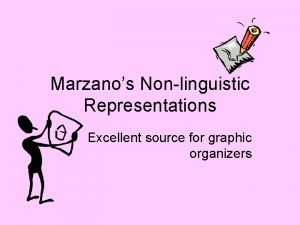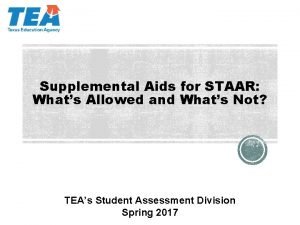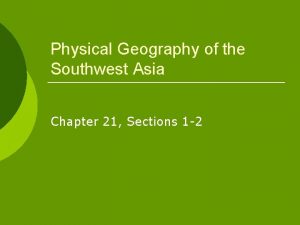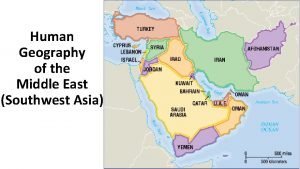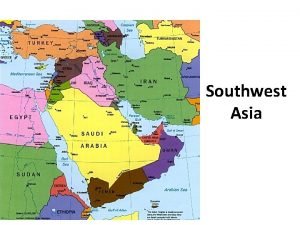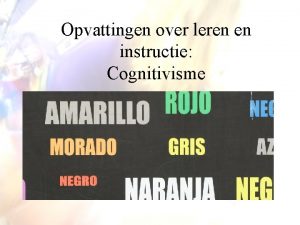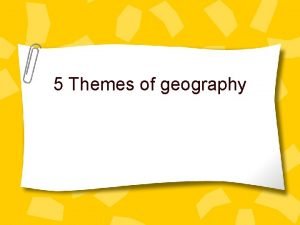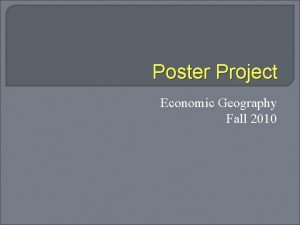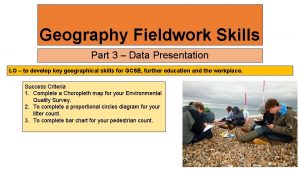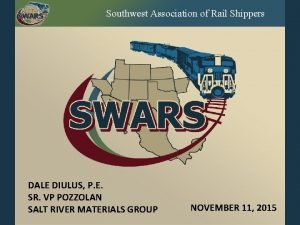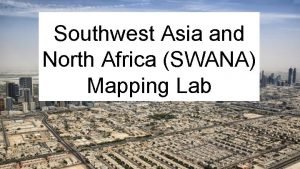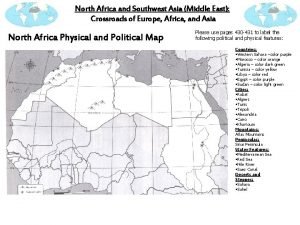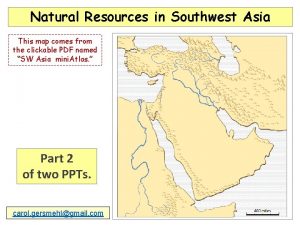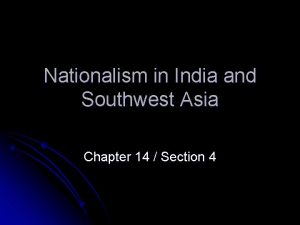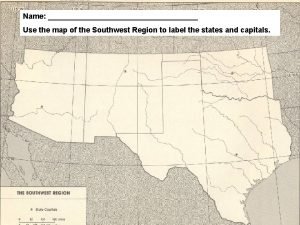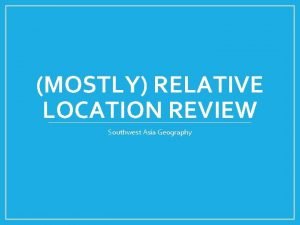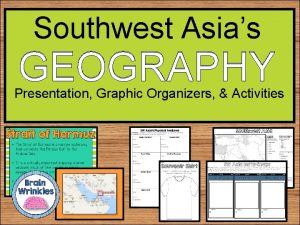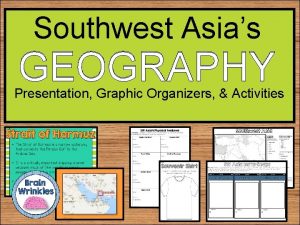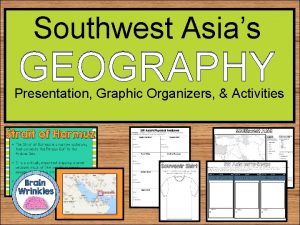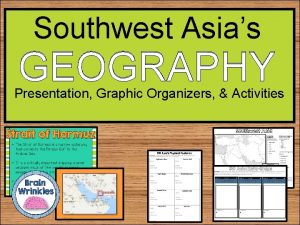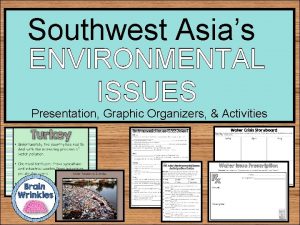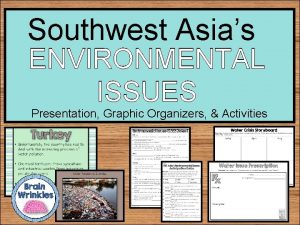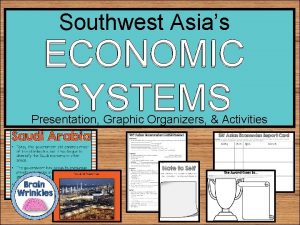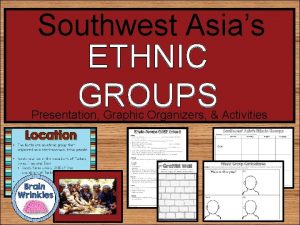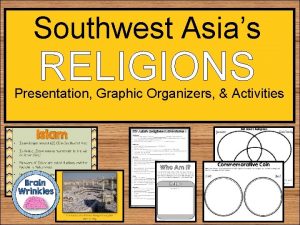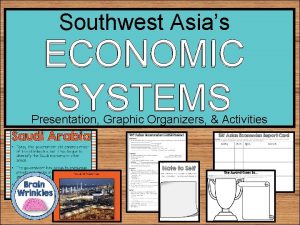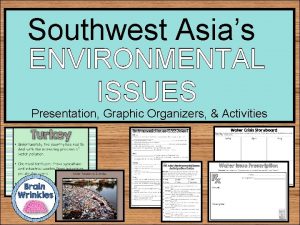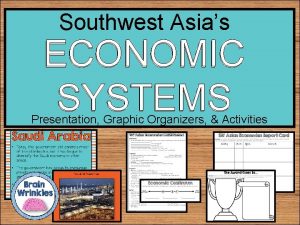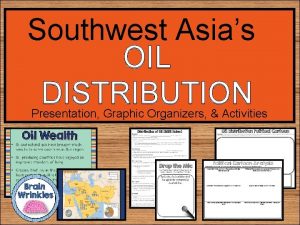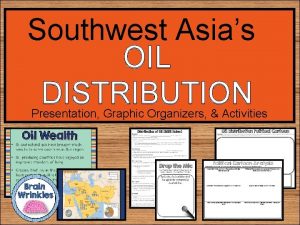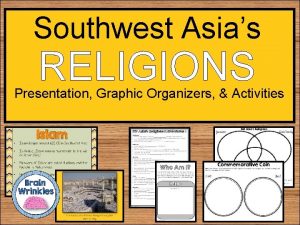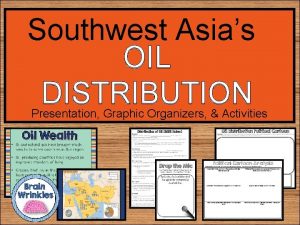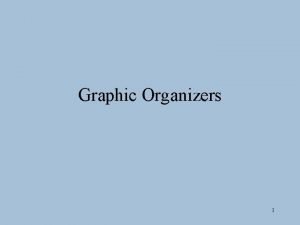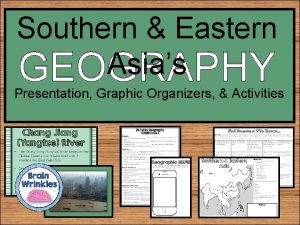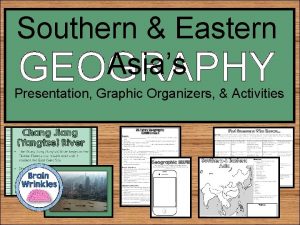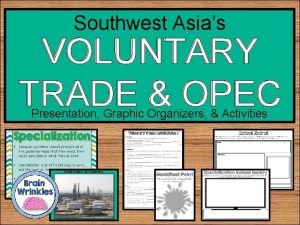Southwest Asias GEOGRAPHY Presentation Graphic Organizers Activities Southwest




















































- Slides: 52

Southwest Asia’s GEOGRAPHY Presentation, Graphic Organizers, & Activities

Southwest Asia I. Political Features: Label the following countries on the map: • Afghanistan • Iraq • Israel • Saudi Arabia • Turkey II. Physical Features: Create a map key that includes symbols for: • Rivers • Seas • Canal • Gulf • Strait • Gaza Strip Label the following physical features: • Euphrates River • Jordan River • Tigris River • Suez Canal Map Key • Persian Gulf • Strait of Hormuz • Arabian Sea • Red Sea • Gaza Strip Draw the symbol for each feature next to the correct label on the map. Color all symbols! © Brain Wrinkles

SW Asia’s Physical Features What: Red Sea Arabian Sea Strait of Hormuz Persian Gulf Directions: Complete the chart below with information that you learn during the presentation. If time allows, color your illustrations. What: Where: Euphrates River Where: Illustration: What: Where: Tigris River Where: Illustration: What: Where: Jordan River Where: What: Illustration: What: Where: Illustration: Suez Canal Illustration: © Brain Wrinkles

SW Asia’s Physical Features Gaza Strip Directions: Complete the chart below with information that you learn during the presentation. If time allows, color your illustrations. What: Where: Illustration: © Brain Wrinkles

Southwest Asia’s Geography © Brain Wrinkles

Middle East • The Middle East is also known as the “crossroads of the world” because of its location in the center of three continents – Asia, Africa, and Europe. • Deserts are the most common physical feature here and make up 66% of the area. • Water is scarce in the region, with countries often competing over access to the rivers and seas. © Brain Wrinkles

© Brain Wrinkles

Euphrates River • The Euphrates and Tigris Rivers both start in the mountains of Turkey and run parallel to each other in some places. • In southern Iraq, the Euphrates River joins with the Tigris River to form one waterway called the Shaat al-Arab. • It then flows along the border between Kuwait and Iran and empties into the Persian Gulf. © Brain Wrinkles

© Brain Wrinkles

Euphrates River • The Euphrates is the birthplace of the ancient civilizations of Sumer, Babylon, & Assyria. • It is a source of water for Iraq, Syria, and Turkey today. © Brain Wrinkles

© Brain Wrinkles

Tigris River • Along with the Euphrates, the Tigris was part of ancient Middle Eastern civilizations. • The rivers provide water for both drinking and farming. • The Tigris River flows through Turkey to Iraq. • The countries that share these rivers have had problems over how the water should be shared. © Brain Wrinkles

© Brain Wrinkles

Jordan River • The Jordan River starts in the mountains of Israel, Lebanon, and Syria, and flows south until it reaches the Dead Sea. • It is only 20 feet wide at some parts and only 17 feet deep at its deepest point. • This river is a main source of water for Israel, Lebanon, Jordan, parts of Syria, & many of those living in the West Bank & the Gaza Strip. • The Jordan River is also important because it is the political boundary between Israel, the West Bank, & Jordan. © Brain Wrinkles

© Brain Wrinkles

© Brain Wrinkles

© Brain Wrinkles

Suez Canal • The Suez Canal connects the Red Sea to the Mediterranean Sea. • It is a 120 -mile man-made waterway that is used to transport goods to and from Asia, Africa, & Europe. • The Suez Canal is important shortcut because it allows trade between all three continents. • At the northern end of the Red Sea, ships can enter the canal and can get to the Mediterranean Sea without having to sail all around the continent of Africa. © Brain Wrinkles

© Brain Wrinkles

© Brain Wrinkles

© Brain Wrinkles

Persian Gulf • The Persian Gulf is a shallow body of water between Iran and the Arabian Peninsula. • This area holds some of the most important oil fields in the world. • It is one of the main ways oil is shipped from the rich fields of Kuwait, Saudi Arabia, Iran, and other countries that line its shores. • All of the countries that produce oil in that region depend on the Persian Gulf as a shipping route. © Brain Wrinkles

© Brain Wrinkles

© Brain Wrinkles

© Brain Wrinkles

© Brain Wrinkles

Strait of Hormuz • The Strait of Hormuz is a narrow waterway that connects the Persian Gulf to the Arabian Sea. • It is a critically important shipping channel because much of the world’s oil supply passes through this strait. • Any ships coming out of or into the Persian Gulf must navigate through this very narrow waterway. © Brain Wrinkles

© Brain Wrinkles

© Brain Wrinkles

© Brain Wrinkles

Arabian Sea • The Arabian Sea is located north of the Indian Ocean and is bordered by India to the east, Pakistan and Iran to the north, and the Arabian Peninsula to the west. • For centuries, it has formed a key shipping route between Europe and India through the Suez Canal. © Brain Wrinkles

© Brain Wrinkles

© Brain Wrinkles

Red Sea • The Red Sea is an arm of the Indian Ocean that lies between northeast Africa and Asia. • It is linked to the Mediterranean Sea by the Suez Canal. • Because of the Red Sea’s location between Europe and East Asia, heavy shipping traffic takes place here. • During the Middle Ages, it was a key part of the Spice Trade. © Brain Wrinkles

© Brain Wrinkles

© Brain Wrinkles

© Brain Wrinkles

© Brain Wrinkles

Gaza Strip • The Gaza Strip is located along the southeastern shore of the Mediterranean Sea, and is bordered on the south by Egypt, and on the north and east by Israel. • The Gaza Strip is a rectangular territory that is about 25 miles long and 4 to 5 miles wide. • It’s one of the world’s most densely populated areas. © Brain Wrinkles

© Brain Wrinkles

© Brain Wrinkles

Gaza Strip • The Gaza Strip is often politically unstable and there have been many outbreaks of violence over the last 60 years. • Disputes over this territory continue between Israel and surrounding countries. © Brain Wrinkles

© Brain Wrinkles

FLYSWATTER REVIEW • One member from each team will come to the board. • I will call out different political and physical features of Southwest Asia. • If you know where the feature or country is located, you should hit the location on the map. • The first person to correctly hit the location wins a point! © Brain Wrinkles

© Brain Wrinkles

Be the Thing… Your Task: • Choose ONE of SW Asia’s physical features and we’ll try to guess what you are! • Imagine that you are one of the physical features of SW Asia. Using descriptive details, include at least 5 interesting facts about yourself. • Draw a colorful illustration of the feature underneath your description. © Brain Wrinkles

Example: Can you believe it? I didn’t even exist less than two hundred years ago. Everyone says that I’m super important to the economy and blah, but I am so tired of everybody always using me. Chug, chug across me all day long. I miss the good ol’ days when I could relax and look out over the oil fields. All I see now are people in such a hurry to reach the other side. © Brain Wrinkles

Suez Canal © Brain Wrinkles

SW Asia Insta-Snaps Directions: Imagine that you just took a trip around SW Asia. What are three noteworthy things that you would want to take a picture of and post on Instagram for all of your followers to see? Make sure you include a #_____ so that they know what your picture is showing. Yes, you can use filters when coloring your pictures! Be creative! Insta-Snaps © Brain Wrinkles Insta-Snaps

Southwest Asia Comprehension Check 1. Which physical features make trade easier? 2. Much of the world’s oil supply is shipped through which waterway? 3. What is the body of water between northeast Africa and Asia called? 4. Which river is the key water source for Israel, Lebanon, and Syria? 5. Are there any physical features countries might fight over? Why do you think they would do this? 6. Which small territory has been a source of dispute between Israel and neighboring countries for years? 7. Which features holds massive reserves of oil? 8. What is the man-made structure that connects the Red Sea to the Mediterranean Sea called? 9. Which two rivers were the birthplace for ancient Middle Eastern civilization? © Brain Wrinkles

Name: Souvenir Shirt Design a t-shirt that represents your favorite physical feature from the lesson. © Brain Wrinkles

Terms of Use © Brain Wrinkles. Your download includes a limited use license from Brain Wrinkles. The purchaser may use the resource for personal classroom use only. The license is not transferable to another person. Other teachers should purchase their own license through my store. This resource is not to be used: • By an entire grade level, school, or district without purchasing the proper number of licenses. For school/district licenses at a discount, please contact me. • As part of a product listed for sale or free by another individual. • On shared databases. • Online in any way other than on password-protected website for student use only. © Copyright Brain Wrinkles. All rights reserved. Permission is granted to copy pages specifically designed for student or teacher use by the original purchaser or licensee. The reproduction of any other part of this product is strictly prohibited. Copying any part of this product and placing it on the Internet in any form (even a personal/classroom website) is strictly forbidden. Doing so makes it possible for an Internet search to make the document available on the Internet, free of charge, and is a violation of the Digital Millennium Copyright Act (DMCA). Thank you, Ansley at Brain Wrinkles Clipart, fonts, & digital papers for this product were purchased from:
 What is asias largest desert
What is asias largest desert Tea supplemental aids
Tea supplemental aids Math supplemental aids
Math supplemental aids Staar blank graphic organizers
Staar blank graphic organizers Graphic organizers for algebra
Graphic organizers for algebra Mcas accommodations codes
Mcas accommodations codes Censogram
Censogram Staar grammar and mechanics rules
Staar grammar and mechanics rules Marzano graphic organizers
Marzano graphic organizers Mcas graphic organizer
Mcas graphic organizer Chapter 22 human geography of southwest asia
Chapter 22 human geography of southwest asia Kums definition geography
Kums definition geography Chapter 21 physical geography of southwest asia
Chapter 21 physical geography of southwest asia Is middle east in asia
Is middle east in asia Chapter 21 physical geography of southwest asia
Chapter 21 physical geography of southwest asia Splash graphic novel definition
Splash graphic novel definition Ghost graphic story graphic and wayfinding
Ghost graphic story graphic and wayfinding Cues
Cues Advance organizer
Advance organizer Expository advance organizers examples
Expository advance organizers examples Dear organizers
Dear organizers Discourse analysis and vocabulary
Discourse analysis and vocabulary Marzanos 9
Marzanos 9 Cues questions and advance organizers
Cues questions and advance organizers Skimming advance graphic organizer
Skimming advance graphic organizer The statement of cash flows helps users
The statement of cash flows helps users Both indoor and outdoor sports
Both indoor and outdoor sports Support activities and primary activities
Support activities and primary activities Definition of primary activities
Definition of primary activities 5 themes of geography graphic organizer
5 themes of geography graphic organizer Types of tertiary activities
Types of tertiary activities Leisure time presentation
Leisure time presentation Ap human geography political geography frq
Ap human geography political geography frq 5 themes of geography ap human geography
5 themes of geography ap human geography Proruption ap human geography
Proruption ap human geography Geography poster project
Geography poster project Pedestrian count data presentation
Pedestrian count data presentation Occipital brow presentation
Occipital brow presentation Leopold maneuver
Leopold maneuver Southwest airlines flight 1248
Southwest airlines flight 1248 The southwest states and capitals
The southwest states and capitals Southwest va ems council
Southwest va ems council Southwest association of rail shippers
Southwest association of rail shippers Environmental issues graphic organizer
Environmental issues graphic organizer Chapter 21 section 1 landforms and resources answer key
Chapter 21 section 1 landforms and resources answer key Swana political map
Swana political map Swana region
Swana region Physical map of north africa and southwest asia
Physical map of north africa and southwest asia Southwest airlines
Southwest airlines Natural resources in southwest asia
Natural resources in southwest asia Nationalism in india and southwest asia
Nationalism in india and southwest asia Map of the southwest region
Map of the southwest region What is the relative location of southwest asia
What is the relative location of southwest asia






